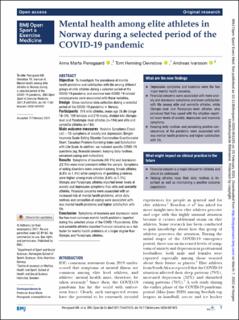| dc.contributor.author | Pensgaard, Anne Marte | |
| dc.contributor.author | Øvrebø, Tom Henning | |
| dc.contributor.author | Ivarsson, Andreas | |
| dc.date.accessioned | 2022-03-21T20:47:33Z | |
| dc.date.available | 2022-03-21T20:47:33Z | |
| dc.date.created | 2021-04-22T19:25:56Z | |
| dc.date.issued | 2021 | |
| dc.identifier.citation | BMJ Open Sport & Exercise Medicine. 2021, 7(1), Artikkel e001025. | en_US |
| dc.identifier.issn | 2055-7647 | |
| dc.identifier.uri | https://hdl.handle.net/11250/2986636 | |
| dc.description | This is an open access article distributed in accordance with the Creative Commons Attribution Non Commercial (CC BY-NC 4.0) license, which permits others to distribute, remix, adapt, build upon this work non-commercially, and license their derivative works on different terms, provided the original work is properly cited, appropriate credit is given, any changes made indicated, and the use is non-commercial. | en_US |
| dc.description.abstract | Objective: To investigate the prevalence of mental health problems and satisfaction with life among different groups of elite athletes during a selected period of the COVID-19 pandemic and examine how COVID-19 related consequences were associated with these variables.
Design: Cross-sectional data collection during a selected period of the COVID-19 pandemic in Norway.
Participants: 378 elite athletes, mean age 26.86 (range 18–59), 159 females and 219 males, divided into Olympic-level and Paralympic-level athletes (n=194) and elite and semielite athletes (n=184).
Main outcome measures: Hopkins Symptoms Check List − 10; symptoms of anxiety and depression; Bergen Insomnia Scale; Eating Disorder Examination Questionnaire Short; Canadian Problem Gambling Index and Satisfaction with Life Scale. In addition, we included specific COVID-19 questions (eg, financial concern, keeping daily routines, perceived coping and motivation).
Results: Symptoms of insomnia (38.3%) and depression (22.3%) were most prevalent within the sample. Symptoms of eating disorders more prevalent among female athletes (8.8% vs 1.4%) while symptoms of gambling problems were higher among male athletes (8.6% vs 1.3%). Olympic and Paralympic athletes reported lower levels of anxiety and depression symptoms than elite and semielite athletes. Financial concerns were associated with an increased risk of mental health problems, while daily routines and perception of coping were associated with less mental health problems and higher satisfaction with life.
Conclusion: Symptoms of insomnia and depression were the two most common mental health problems reported during this selected phase of the COVID-19 pandemic. Elite and semielite athletes reported financial concerns as a risk factor for mental health problems at a larger degree than Olympic and Paralympic athletes. | en_US |
| dc.language.iso | eng | en_US |
| dc.subject | anxiety | en_US |
| dc.subject | COVID-19 | en_US |
| dc.subject | depression | en_US |
| dc.subject | elite performance | en_US |
| dc.subject | mental | en_US |
| dc.title | Mental health among elite athletes in Norway during a selected period of the COVID-19 pandemic | en_US |
| dc.type | Peer reviewed | en_US |
| dc.type | Journal article | en_US |
| dc.description.version | publishedVersion | en_US |
| dc.rights.holder | © Author(s) (or their employer(s)) 2021 | en_US |
| dc.source.pagenumber | 6 | en_US |
| dc.source.volume | 7 | en_US |
| dc.source.journal | BMJ Open Sport & Exercise Medicine | en_US |
| dc.source.issue | 1 | en_US |
| dc.identifier.doi | 10.1136/bmjsem-2020-001025 | |
| dc.identifier.cristin | 1905921 | |
| dc.description.localcode | Institutt for idrett og samfunnsvitenskap / Department of Sport and Social Sciences | en_US |
| dc.source.articlenumber | e001025 | en_US |
| cristin.ispublished | true | |
| cristin.fulltext | original | |
| cristin.qualitycode | 1 | |
